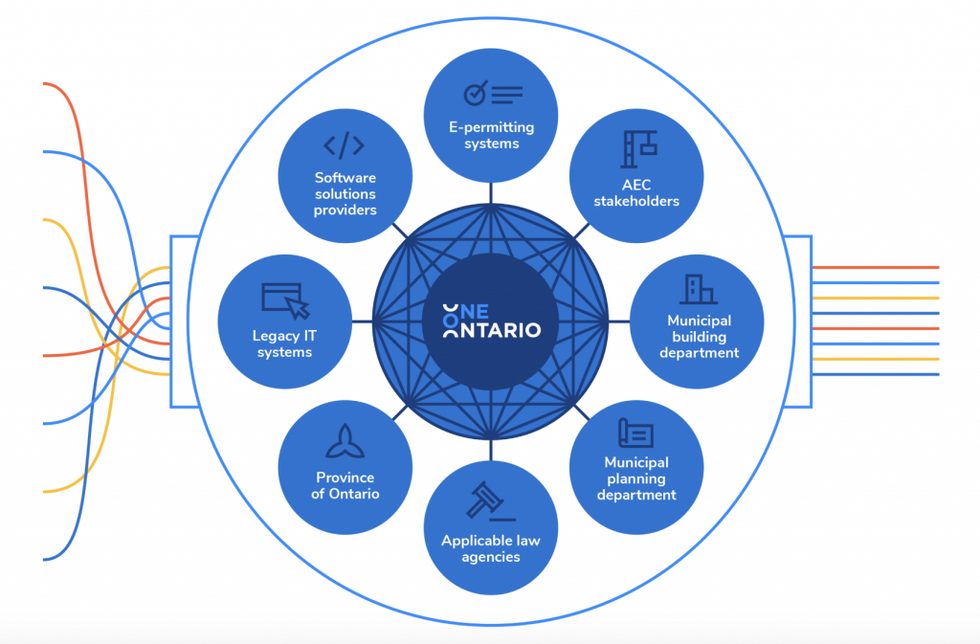With the 1.5M homes by 2031 target looming, the burden is heavy on Ontario’s building sector.
But developers and builders hardly have their work cut out. It costs a lot to get housing built, these days especially, and the lengthy processes associated with getting developments off the ground does little to motivate those with the ability to build to actually do so.
It’s been clear for some time that something’s got to give.
The Residential Construction Council of Ontario (RESCON) -- Ontario's leading association of residential builders -- has been rallying for change. Since September, the association has called for 15-points of reform “to get more shovels in the ground” and emphasized the need to modernize, centralize, and streamline development approvals.
In early October, with support from RESCON, AECO Innovation Lab launched the One Ontario pilot program in Simcoe County, introducing a centralized, one-window digital platform to the region’s pre-construction process. The idea is to “streamline pre-construction processes and help get housing and affordable housing built faster,” said AECO CEO Arash Shahi in a news release from October. “The blueprint that we have developed will remove barriers, eliminate data silos, and ensure applications can be processed more quickly to improve housing affordability in the region.”
One Ontario is one of 14 initiatives to receive funding through the second round of the Housing Supply Challenge, which invites citizens, stakeholders, and experts to propose solutions to the housing supply crisis. In this round of the Housing Supply Challenge specifically, participants were encouraged to submit solutions geared at improving the pre-development processes in local markets.
“We know there is a real need for regional governments to facilitate certainty, transparency, and fairness in pre-construction processes. These processes are lengthy and complex, resulting in delays and increased costs that lead to higher housing prices, lower supply, and fewer affordable housing units,” a spokesperson for the CMHC tells STOREYS. One Ontario was selected because it targets barriers to housing supply at a systemic level, and stands to strengthen and standardize communication between all entities involved in the building process.

Although the intention is to roll One Ontario out across the province -- and eventually, across the country -- Simcoe County was selected for the pilot because it exemplifies the development pressures being faced on a greater scale.
“Simcoe County is also very representative of upper tier or regional jurisdictions across Canada, with a mixture of rural, urban, and First Nations perspectives, so it seems like an ideal jurisdiction for the pilot,” says Mark Anderson, Director of Business Development, AECO Innovation Lab.
As for the platform itself, Anderson says nothing like it is currently in use.
“There are no standard processes for development applications -- every municipality has different requirements. Outside of the municipality, there can be 40-plus agencies and groups that get involved reviewing, commenting on, or approving applications,” he says. Not only does this slow down the approval process, but it makes it impossible for developers to anticipate how long an application will be in limbo. “Without exception, the development community wants faster permits, but on top of that they want standard intake, consistent process, and transparency into where their application is at.”
Although Ontario’s building sector has historically been slow to adopt new systems, the Government of Canada’s latest immigration targets have made it clear that there’s little time to stall. At this stage in the game, Ontario needs to get ahead of its supply crisis, and a platform that promises to get new developments off the ground faster is undoubtedly a move in the right direction.
But One Ontario is still in its early days.
Though Anderson says the pilot has had “great buy-in” at both municipal and regional levels of government, there’s still a ways to go before it will be extended outside of Simcoe County.
“Unfortunately, because there are so many players -- municipal governments, regional government, conservation authorities, applicable law agencies -- involved in the development approval process in Ontario, there is a lot of coordination needed to address the challenge,” he says. “Getting support and funding to move this forward in Ontario and across Canada is the larger challenge. The technology has been proven in many other international jurisdictions, but significant localization is required to make it a solution.
“CMHC is encouraging us to grow the pilot to other communities and stack funding from other sources including the provincial government. With buy-in from the federal side, we anticipate the province will join the effort. Addressing the housing crisis requires all hands on deck.”





















